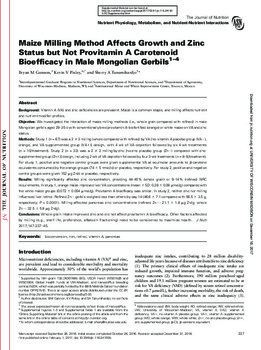Mostrar el registro sencillo del ítem
Maize milling method affects growth and zinc status but not provitamin A carotenoid bioefficacy in male Mongolian gerbils
| Autor: | Gannon, B.M. |
| Autor: | Pixley, K.V. |
| Autor: | Tanumihardjo, S.A. |
| Año: | 2017 |
| URI: | https://hdl.handle.net/10883/19381 |
| Resumen: | Background: Vitamin A (VA) and zinc deficiencies are prevalent. Maize is a common staple, and milling affects nutrient and nutrient-modifier profiles. Objective: We investigated the interaction of maize milling methods (i.e., whole grain compared with refined) in male Mongolian gerbils aged 29–35 d with conventionally bred provitamin A–biofortified (orange) or white maize on VA and zinc status. Methods: Study 1 (n = 67) was a 2 × 3 milling (whole compared with refined) by VA [no–vitamin A placebo group (VA−), orange, and VA-supplemented group (VA+)] design, with 4 wk of VA depletion followed by six 4-wk treatments (n = 10/treatment). Study 2 (n = 33) was a 2 × 2 milling-by-zinc [no-zinc placebo group (Zn−) compared with zinc-supplemented group (Zn+)] design, including 2 wk of VA depletion followed by four 3-wk treatments (n = 8–9/treatment). For study 1, positive and negative control groups were given supplemental VA at equimolar amounts to β-carotene equivalents consumed by the orange groups (74 ± 5 nmol/d) or placebo, respectively. For study 2, positive and negative control groups were given 152 μg Zn/d or placebo, respectively. Results: Milling significantly affected zinc concentration, providing 44–45% (whole grain) or 9–14% (refined) NRC requirements. In study 1, orange maize improved liver VA concentrations (mean ± SD: 0.28 ± 0.08 μmol/g) compared with the white maize groups (0.072 ± 0.054 μmol/g). Provitamin A bioefficacy was similar. In study 2, neither zinc nor milling influenced liver retinol. Refined Zn− gerbils weighed less than others by day 14 (46.6 ± 7.1 compared with 56.5 ± 3.5 g, respectively; P < 0.0001). Milling affected pancreas zinc concentrations (refined Zn−: 21.1 ± 1.8 μg Zn/g; whole Zn−: 32.5 ± 5.8 μg Zn/g). Conclusions: Whole-grain intake improved zinc and did not affect provitamin A bioefficacy. Other factors affected by milling (e.g., shelf life, preference, aflatoxin fractioning) need to be considered to maximize health. |
| Formato: | |
| Lenguaje: | English |
| Editor: | American Society for Nutrition |
| Editor: | Oxford University Press |
| Copyright: | CIMMYT manages Intellectual Assets as International Public Goods. The user is free to download, print, store and share this work. In case you want to translate or create any other derivative work and share or distribute such translation/derivative work, please contact CIMMYT-Knowledge-Center@cgiar.org indicating the work you want to use and the kind of use you intend; CIMMYT will contact you with the suitable license for that purpose. |
| Tipo: | Article |
| Lugar de publicación: | United Kingdom |
| Páginas: | 337–345 |
| Número: | 3 |
| Volumen: | 147 |
| DOI: | 10.3945/jn.116.241935 |
| Palabras Claves: | Vitamin A |
| Agrovoc: | BIOCONVERSION |
| Agrovoc: | CAROTENOIDS |
| Agrovoc: | MAIZE |
| Agrovoc: | RETINOL |
| Agrovoc: | PANCREAS |
| Agrovoc: | GERBILS |
| Datasets relacionados: | https://oup.silverchair-cdn.com/oup/backfile/Content_public/Journal/jn/147/3/10.3945_jn.116.241935/8/nutrition241935supplementarydata1.pdf?Expires=1575563035&Signature=z4wXibdnRyUOOOSEpDoJJf-MFYV0Qe2CmvRr~8Ssvdze3DK1cTlMawSLh7SiVZ0-nYw68N3FvKXJC8Cj1o6wfu7TnxuKmChqwXDAl23RmASNs0M1K60F9BWMaMNNqikhAdl2NvzpCihVi6ImOD0Ny1X7YTJrLLLDa2fJr5mtD7X8MkZSl9qnoAggwH9EH5UQCL-SiDnNqH~-~BR3z6-jlQPjxuPZCwAY9tDgDscQVr6zsa1aW54zD4avBpgKVrMZcBiCGTR3bSS20V1ITiTBPaqncP1fkVVoS4SL3ziQACJVeTnXuYKvVBn6IslemqiuAxNVeFjUi-jGS8t6Y~UXcQ__&Key-Pair-Id=APKAIE5G5CRDK6RD3PGA |
| Datasets relacionados: | https://oup.silverchair-cdn.com/oup/backfile/Content_public/Journal/jn/147/3/10.3945_jn.116.241935/8/nutrition241935supplementarydata2.pdf?Expires=1575563035&Signature=2e1ZRIDD-q1AbUO7NmAdQizwmGBHdDeH~Uzq6nWjX0qBwIlaIm39mPiAkYi-~PoR5uSs3iQL6mxAy6RJnyQKDlBTVkS-7~H-nB6pPAcaek4PkKUjlQol3z87iFdJE~Ht~09swvcwtha6jH8SkkExPQkXV-cadB2Szj3bIgzk39er8UaACIL6TiC6W2GYRC7QTPxrg2BehZB6l7Tl0VylNFZ26aSyICIk~qTKGPVVN9Q~4QHohfzO41AwZqpw-DnZNTOuMdjWR2I1L~HXWNINAzLaVEYnEL-d-EIO~UtGZuJ1WJglsZei9~jkino8rGx9wI~zbPI8NLdE5XvWUL7Qog__&Key-Pair-Id=APKAIE5G5CRDK6RD3PGA |
| Datasets relacionados: | https://oup.silverchair-cdn.com/oup/backfile/Content_public/Journal/jn/147/3/10.3945_jn.116.241935/8/nutrition241935supplementarydata3.pdf?Expires=1575563035&Signature=qRoh9HO4M3R06JApHAZo7QBRsm9hkhk9F3xo1OIEQXZ7U~Mek0l~sgYENbNMx-E2YxCx2iMvfvJ71xTi~W9CjL6O-TKb5~nND~8F2~CemR2CdnnghRCwrZPuwcRgwPHlrYo5q8vAJ8YUWidXz53V170AVdiHcciVOJeKNBe19SNjq9wPGWOh2JgNWkW0ASas~LFGM6V-4F-cEeVUQ0UN4snFQgvQMNXKToqUrLWAYaQENmCRZh~ieuJszl5tbhciYIi-WfDX7hkiWEkqkcLD4iUW~AN0AqPd0Z7UQWDp1f5okcBX-SLMwljTAUpxfWhv3yrXNhLLoFScUzON-xT98g__&Key-Pair-Id=APKAIE5G5CRDK6RD3PGA |
| Datasets relacionados: | https://oup.silverchair-cdn.com/oup/backfile/Content_public/Journal/jn/147/3/10.3945_jn.116.241935/8/nutrition241935supplementarydata4.pdf?Expires=1575563035&Signature=4082PD~KnYwRnjjpHFbjaQeP279L9l7s8iZvZT5PzKA1MhyNGAWlsQg5DRcikpHHMqsmh5bLu6xkQ2EvrINJ4mYuX-ihlS7PDhk1LOsLgXwxP1~76h8mf-OnwO-FtdK2Fez~8x54VDRz5HSUUmLg95sQGNz6r0HeNavaaJE6TS-5e28y2WNSC06ULG~CA5Ey4ALBMWGo9eFha7CEFscSHwf0gH7gos-PGCzeOLJ6VCnFhBxVzmXvTwNMsZQF~JJ8ixuFOZIx5EYvFFn~x4uwf0AJfFz63p0NeyvtZA8wHX37XcSTFNhwigRyriCUYP~qIiMDfUOgnmqSJNnxEF7PTg__&Key-Pair-Id=APKAIE5G5CRDK6RD3PGA |
| Revista: | The Journal of Nutrition |
Ficheros en el ítem
Este ítem aparece en la(s) siguiente(s) colección(ones)
-
Genetic Resources
Genetic Resources including germplasm collections, wild relatives, genotyping, genomics, and IP

